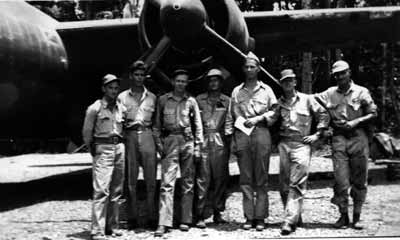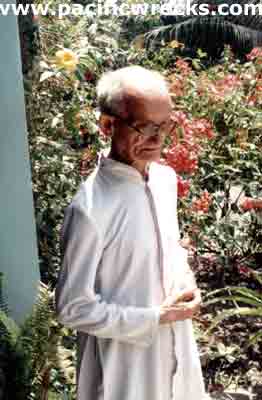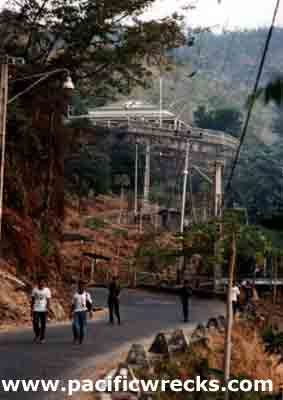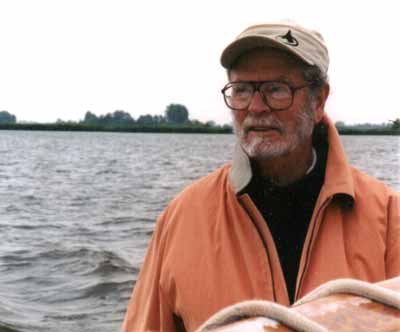
Harry Nelson, July 2001
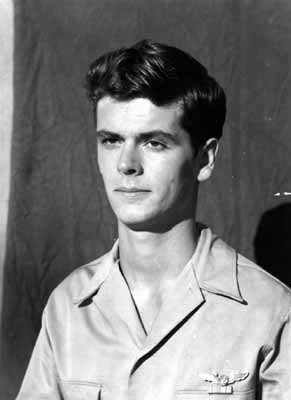
Harry Nelson, May 1943

Destroyed building
near military hospital, Dilli 1991
Background
As for my army experience, I joined up in July
1941 at age 18. Was assigned to the 22nd BG in September as a photo-gunner
(had no training in either field), left our base at Langley Field
on Dec. 8, 1941 headed for California to defend the coast from Jap
submarines, flew missions over the Gulf of California looking for
subs (saw none); sent to Hickam Field in Hawaii in Feb. 1942; in April
1942 island hoped from Hawaii to Palmyra to Canton Island to Fijji
to New Caledonia to Brisbane to Townsville.
Combat Missions
Flew my first combat mission April 21, 1942 three
days after my 19th birthday. The mission was to take photos of a Japanese
radio station at the western tip of New Britain Island.
Mission to Dili, Timor
I was a photo-gunner on a B-26 with the 408th
BS, 22nd BG on a mission to bomb Dilli on Timor in 1942. I believe the mission was sometime in July. We
were told that the target was a hospital with a large red cross painted
on the roof which the Aussie troops still on the island had informed
headquarters in Australia was actually an ammunition dump.
I cannot recall the name of the pilot on that mission nor the plane name or number. All I recall is that the mission was in July 1942 and that there were two other planes in the flight. Some day if our group history ever gets printed I may learn all the data. The history is supposed to have all the details of every mission. I do have a photo of myself with Lt. Robert at Seven Mile strip near Port Moresby, New Guinea. The co-pilot of that crew, Lt. John Wells, was also on a Timor mission, but his mission apparently was on a different date than mine. The name of that plane was "Wee Winnie" and number 1430. As for the name of the strip at Darwin, I'm guessing it was Bachelor.
There were three B-26s in the flight. I do not recall the names of any of the pilot-- unfortunately not even the pilot of the crew I was on. I recall that we went in very low. I have no idea whether we hit the target. I recall no ack ack or ground fire. I was the tail gunner and took no pictures.
A lone Zero followed us at a good distance back to our airstrip south of Darwin. I don't recall the name of the strip but it seems to me at had the word crockodile in it. Because I have often wondered whether the target really was an amuniton dump, about 8 years ago [ in 1991] my wife and I went to Dilli with the intention of finding someone who was there in July 1942.
New Information
I have recently learned new information concerning
our Dili missions which sheds a different light on what follows in
this section below. First, the missions were not in July 1942 but
in November 1942. Second, we did not bomb low level but at about 8000
feet. Third, one of the targets was not a "hospital" camaflaughing
an ammo dump but it was a cathedral covering a supply dump. Also,
two other squadrons from the 22nd Bomb Group participated. They were
the 2nd and the 19th. The pilot of my crew was Lt. Wade Robert. It
turns out that the cathedral was hit hard. One of the pilots, Capt.
Michaelis, was an attache in Australia after the war.Years later he
learned that one of the bombs dropped on the cathedral failed to explode.
He met the
Australian consul who was stationed at Dili and under house arrest
by the Japanese at the time of the raid. The consul told Michaelis
about the rough time the Japs had getting the bomb out of the cathedral.
These facts are in sharp contrast with my recollections of events 59 years later. This story illustrates how faulty our memories of things past can be. I think my memory of a low-level mission somehow got mixed up with one such mission I flew over an airfield at Rabaul very early in the war before we moved upstairs quite a few thousand.
Cy Klimesh of the 22nd
BG Website adds:
"Regarding the "hospital" cited by Nelson, in fact
the target was the cathedral. Nelson flew the first and third missions,
on 2 and 4 November 1942, both with Lt. Roberts. As reported by the
Australian console a bomb dropped by the 19th Sqd. on 3 November during
the 2nd strike fell into the building but failed to explode. The building
was being used as a supply warehouse. One B-26 was hit over target
and ditched about 100 miles from the Australian coast with the loss
of one
life."
Returning to Timor 1991
The International Red Cross representative told
me the best source would be a Catholic priest. The priest at what
seems to be the main church was, as I recall, Father Eduardo Brito.
He spoke good English. He said that he had not been in Dilli in 1942
but that an old priest was living with the nuns at their quarters
and he had been in Dilli during the war. I found the priest, who was
very old and frail and who spoke very broken English. He said that
he remembered lots of bombing raids but that he had no recollection
of any hospital being bombed.
I have a photo of Father Carlos Moetel,the elderly Catholic priest whom I interviewed to learn whether he recalled any hospital being bombed; a photo of a hospital with a red cross on its roof which is located at the foot of a hill like the location I vaguely recall on the bombing mission; and a photo of my wife and myself with Father Eduardo Brito, the priest who led me to Carlos.
As for my visit to Dilli in 1991, my wife and I were spending a month in Indonesia, which you probably know, now includes what used to be the Dutch half of New Guinea. It's now called Irian Jaya. Later in the war I was based in several places in the old Dutch East Indies, so I wanted to go back to see some of the places. Dilli was on the top of the list because I had always wondered whether our target was really an ammo dump.
I wanted to go also because East Timor was a hot bed because of the indpendence movement that blossomed fully several years later. I wanted to see the conditions for myself. Part of the reason was because in civilian life I was a newspaper reporter for the Los Angeles Times and I specialized in covering medicine and healthcare. I had done a lot of reporting on health conditions in developing countries and was anxious to see how things were in Indonesia and especially East Timor because of the independence movement.
Conditions were miserable in Dilli, as in the rest
of East Timor. Food for the average person was scarce and poverty
high. The Indonesian army was in tight control and fighting with the
rebels was taking place in the mountains and occasionally in Dilli.
Iran into an American Maryknoll nun who taught school there said the
people survive by giving in to the army. She said most of her students
were orphans. If you read the newspapers in 1999 you know as much
as I do about the problems there.
Nineteen More Missions
Flew 19 more missions over Rabaul, Lae, Salamaua
and in May 1943 was transfered back to the states to train photo-gunners
at McDill Field, Tampa. Several months later a physical exam found
my eysight failed to meet standards and was grounded.
I was reassigned to a photo technical squadron as a lab technician and returned to the South Pacific in April 1944. Based in Guadalcanal, Admiralty Islands, Nooemphor and Morotai in the Dutch East Indies, and finally on Leyte where I ended up the war. Discharged October 1, 1945.
